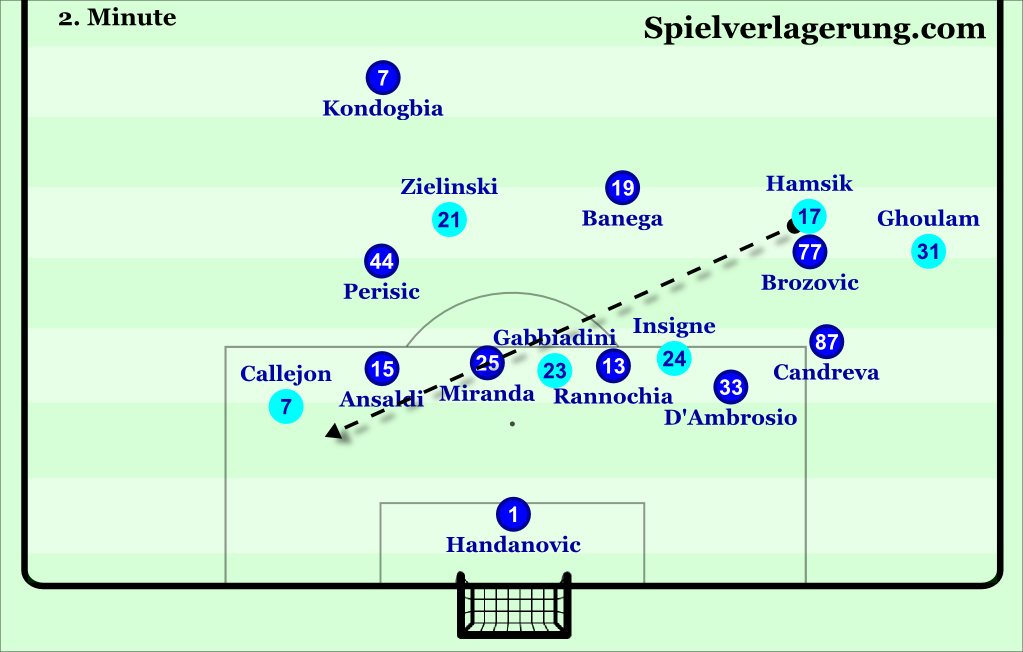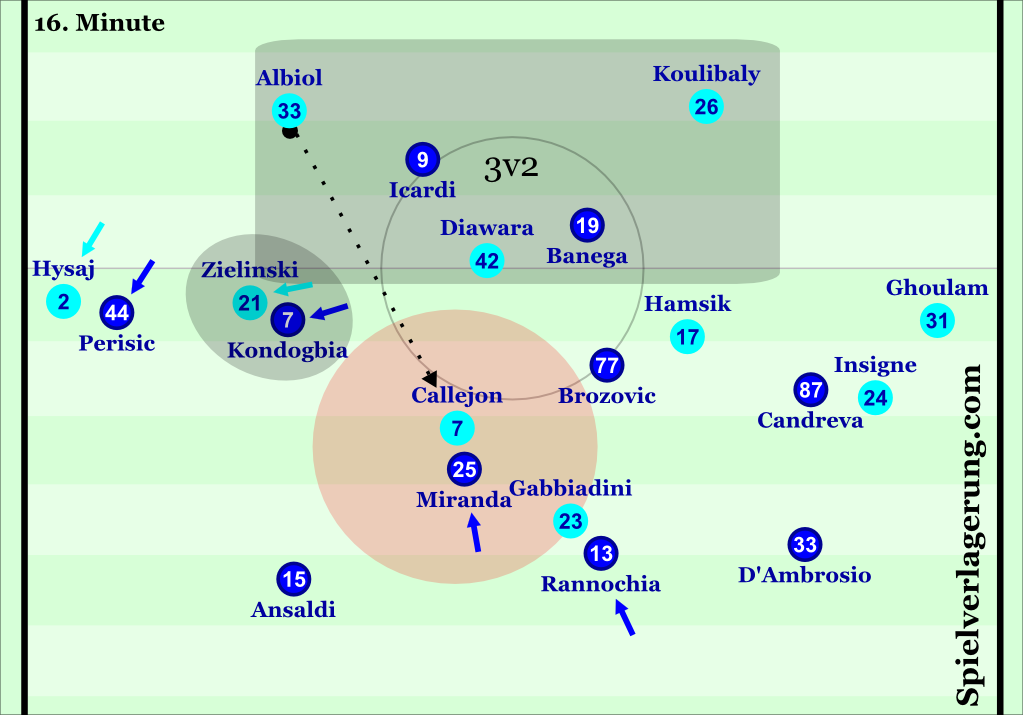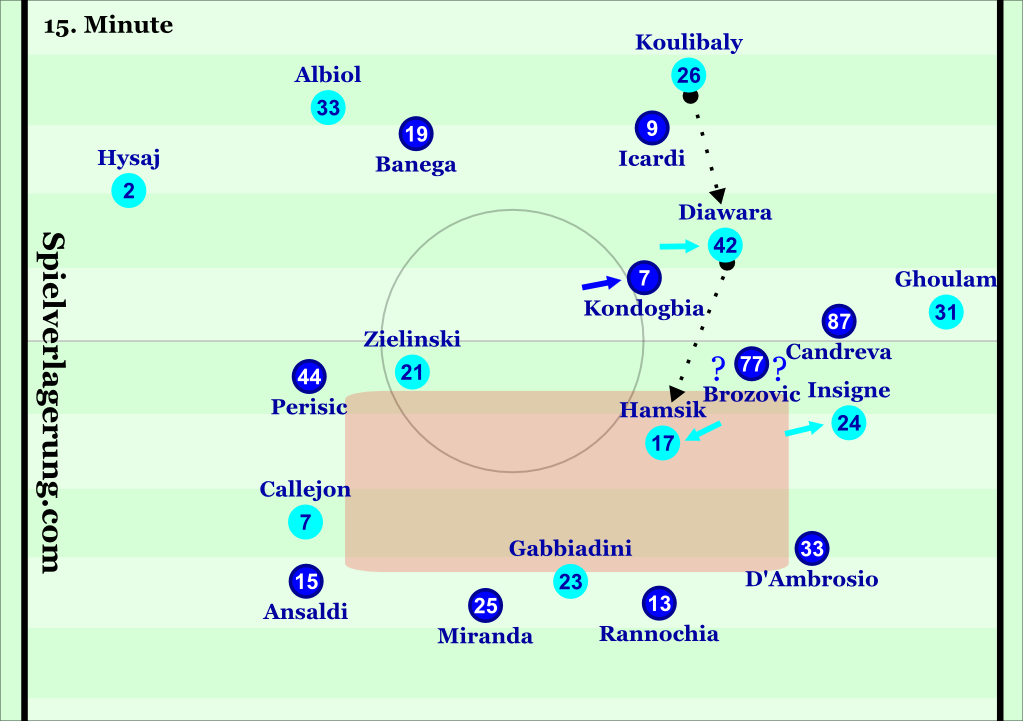Sarri’s Napoli in rampant home victory
Napoli hosted Internazionale in Serie A’s first gameweek 15 fixture. With the stature of the two clubs this has often been a top of the table clash. However, the two sides came into this game in 7th and 8th spots respectively. Milik-less Napoli have struggled to utilise some of their usual offensive approach play, and have thus experienced an inconsistent attacking output in addition to a generous defence. Inter on the other hand have had inconsistent results from the start, with highs such as a home victory over Juventus marred by defeats to the likes of Cagliari.
Napoli’s offensive game
Throughout the game a number of characteristics of Napoli’s offensive game were on display. One of these characteristics was a use of diagonal passes towards the far post, particularly on the right flank. By passing backwards they provoke a defensive line to move forwards. In addition, the back passes usually move the ball into an area with lower pressure meaning the player on the ball has more time.
With the left side of Napoli’s team being more combination focused these passes usually take place around the left half space. In this zone, back passes are often a trigger for Callejon to move diagonally into the box. By timing his movement in line with the opposition defence moving forwards he is able to gain a dynamic advantage, allowing him to receive in the box. An inherent use of the blind side is another element of these runs. With the ball on one side and Callejon running on the other the defender’s reference points are split, making it difficult to act on both. This was particularly evident in Napoli’s opening goal whereby Callejon headed down a diagonal for Zielinski to strike.
One of the biggest offensive characteristics of Sarri’s Napoli is using central progressions to create space in wider areas. This takes advantage of the inevitable pressure that follows a vertical progression. Opponents naturally collapse on the ball in reaction to vertical passes as they seek to close the quickest route to goal. As such, lay-offs from the receiver play the ball to a forwards-facing player who can then access the space created and progress the play.
Inter’s defensive strategy made them somewhat vulnerable to this pattern. With the midfielders operating in an intensely man-oriented fashion their shape was highly malleable. Therefore, Napoli were able to manipulate their positioning to open space in the centre of the field. With wide and/or forward movements from the likes of Zielinski and Hamsik passing routes to Gabbiadini could be created.
This movement is in line with a general rule Sarri has instilled, namely; players who are covered move forwards whilst a nearby team-mate drops. This movement is used to create an alternative angle for progression which often releases the previously covered player to receive by altering the opponents’ body position and in turn field of vision.
Inter’s pressing issues
Pioli’s side attempted to press Napoli with a distinctly man-oriented approach, particularly in midfield. Although Napoli have at times struggled to make their possession effective against such an approach, there were a number of flaws in Inter’s execution. This combined with some excellent dismarking methods from the home side allowed them to bypass Inter’s pressing efforts on a number of occasions.
Perhaps the main strength of man-oriented defending is the access it can create, although this can also be achieved with other different methods. With defenders sticking tightly to assigned opponents the defending team possess the ability to apply pressure to every receiver. As such man-oriented defending can work well with a high intensity approach whereby the opponents are rushed, each pass is pressured and the cumulative effects of this pressure work to eventually cause mistakes. However when combined with a low intensity approach the results can be fatal…for the defensive team.
This was the biggest flaw in Inter’s pressing. The one forward block created difficulties in controlling Napoli’s 2 defenders in build-up. Banega was tasked with man-marking Diawara, but after switches would move up to pressure the receiving centre back whilst aiming to cover Diawara. The nature of this role saw Banega generally positioned goal side of his opponent, this meant Diawara was available to receive and pass first time across to the other centre back. Diawara along with the centre backs gave Napoli a 3v2 advantage against Icardi and Banega meaning the home side instantly had a free man in build-up.
As such, the low intensity from the forward players was somewhat understandable, however with little pressure on the ball Napoli were able to use their centre backs dribbling to create a free man in midfield. On other occasions Albiol and Koulibaly used the lack of pressure on the ball to pass into players behind lines of Inter pressure. Of course the poor compactness the away side’s strategy caused was a bigger issue since the players on the ball had time to pick passes. This was effective in conjunction with Napoli’s dismarking methods…
Napoli breaking man-orientations
During the course of the game a number of methods were on show as Napoli sought to break past Inter’s man-orientations. One of these methods was positional rotation. Players moving in opposite directions can be a great tool to disrupt man-oriented opponents since it challenges the nearby defenders to co-ordinate their marking in a short space of time. Defenders are naturally reluctant to follow an opponent out of position if another is moving towards them. Until they see that the attacker moving in their direction is marked they can be caught in “two minds”. This brief period of confusion is often enough to create the necessary separation for a previously marked attacker to receive the ball.
Hamsik and Insigne were particularly adept at this with their co-ordinated movements often allowing Hamsik to get free behind the Inter midfield. A common rotation in Napoli’s game model sees Hamsik move deep in the left half space, Ghoulam move to an advanced wing position and Insigne high in the left half space. When the ball moved from the left flank to a forwards-facing Diawara, this was a trigger for Hamsik and Insigne to switch with the Italian moving towards the flank while Hamsik moved diagonally towards the centre.
Through this scheme Napoli were consistently able to access the 10 space as Hamsik’s movement beat the away side’s coverage. This was particularly advantageous since the Slovakian could receive in this space with a forwards facing field of vision which had positive effects on his next action.
Another interesting characteristic that helped Sarri’s men bypass pressure in midfield was the qualities of the players in midfield. This was particularly evident through Zielinski a player who possesses excellent orientation, this allowed him to beat an opponent approaching from behind and access the space they left behind. 
Inter’s wing-oriented attack
When they had the ball Inter suffered from a distinctly wing-oriented attack which reduced their variability. This had a number of different causes, one of which was Inter’s inconsistent structure in possession. Pioli’s side often displayed a double wing-occupation which, combined with an excessive overload in deep areas, meant their occupation of central spaces was weak. It was, therefore, little surprise that many of their advances were made in wide areas with several crosses being a by-product.
Another factor that contributed was the Neapolitans’ strong defensive structure. They consistently showed an advantage of a compact defensive shape by constantly having players in proximity to force the ball away from dangerous spaces.
Conclusion
This was an encouraging win for Sarri’s side, their ability to get free from Inter’s midfield man-orientations was a key aspect in their victory. The Neapolitan faithful will now be hoping for an upturn in form with key clashes such as an all-decisive game at Benfica on the horizon.
As for Pioli’s men their mix of man-orientations and a low intensity press was inevitably fatal, this along with their weak possession game will need to improve if they are to finally return to Champions League football.





2 Kommentare Alle anzeigen
Matt December 13, 2016 um 6:46 pm
Question. If you are defending and you see your team is not compacted vertically do you press the ball or stay and block the passing lane?
tobit December 15, 2016 um 1:29 pm
To me it depends first on the qualities of the men behind you. If they are able to cover the spaces you leave inbehind then you can (and maybe should) keep pressure on the ball. If you have particularly slow and/or immobile defenders it’s probably better to retreat a bit and try to narrow down the spaces in your formation.
A second influence is the quality of the opposing team. If they lack a stable build-up under pressure it can be worth the risk to leave open spaces around your own backline to quickly gain the ball.